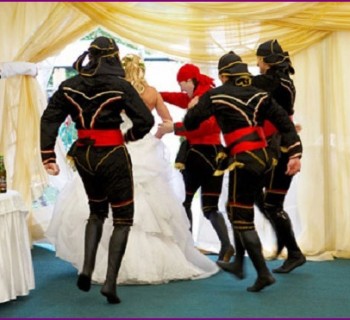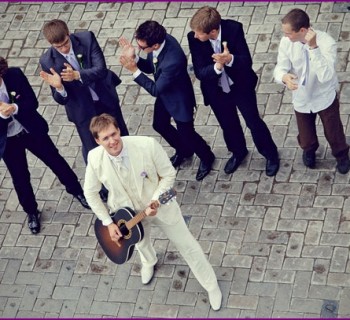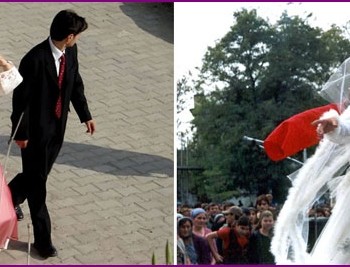Contents
- Chuvash wedding traditions and rites
- National Chuvash wedding clothes
- Video: Chuvash wedding ritual before the wedding
The Chuvash wedding is one of the most important life events (along with birth or death), it symbolizes the transition to a new stage - to create a family, procreation. Strengthening, the well-being of the family since ancient times was actually the life goal of the Chuvash. To die without having been married and not continuing the race was considered a great sin. Preparation and holding of a traditional Chuvash wedding is not just a holiday, but careful observance of rituals that have a sacred meaning.
Chuvash wedding traditions and rites
The wedding traditions of the Chuvash people have ancient roots and are dictated both by everyday realities (for example, kalym or dowry, which reimbursed the wedding expenses for families, helped the young to materially settle down), and religious beliefs (protection from evil spirits, attracting happiness). The wedding process from matchmaking to marriage ritual took several weeks. It was performed in a certain order, which was followed by a specially selected man from the groom's relatives.
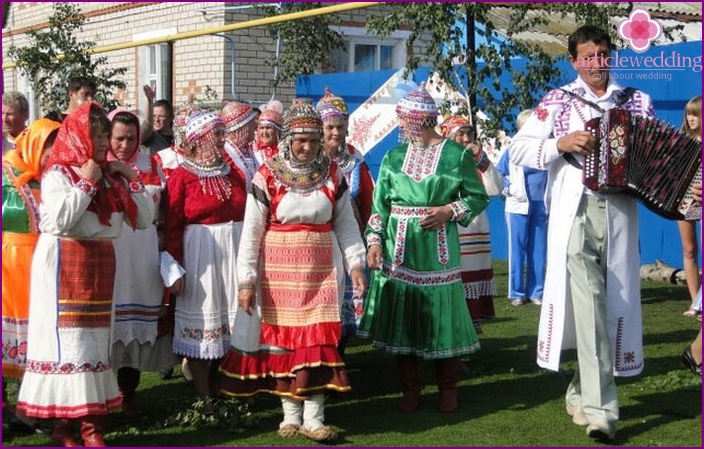
Dating and choosing a bride and groom
In search of the second half, the Chuvashs decided to go away from their native village. It was better if the girl lived in neighboring and distant settlements, so as not to accidentally choose one of the relatives as a wife. Residents of one village could be in close or distant kinship, and according to the Chuvash tradition, it is forbidden to marry relatives up to the seventh generation.
In this regard, the holidays common for several villages were commonplace - there, as a rule, acquaintances between Chuvash youth took place there. Sometimes the parents engaged in the choice of the groom / bride, but according to tradition, it was customary to ask young people for consent before the wedding. The girl’s sympathy was expressed by giving a hand-embroidered scarf to a chosen one, and the guy treated his beloved with gifts.
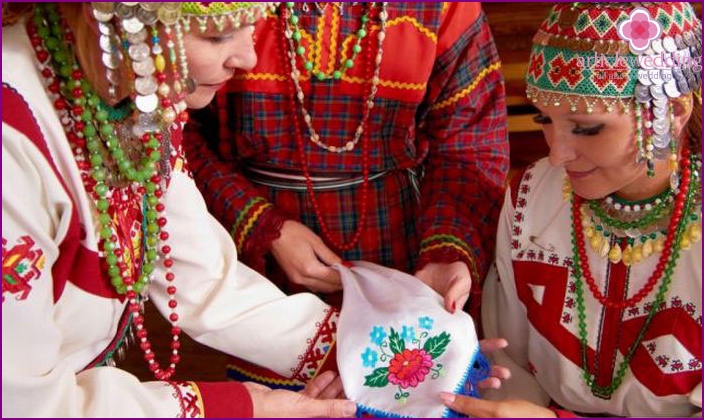
Having chosen a bridegroom, the future bridegroom announced this to the parents, who had to make sure before the wedding that they would take a healthy, well-bred girl into their family. Since the future wife was to become a full-time worker in her husband’s house, her hard work and housekeeping skills were evaluated especially carefully. Chuvash mature brides were traditionally considered more valuable than young ones, because the latter usually have less dowry and management experience.
The rite of matchmaking
The Chuvash people consider spring the most popular time for matchmaking. According to tradition, matchmakers were sent to the girl: the senior friend (a close relative of the groom who was negotiating with the bride's parents), the younger friend (selected among the young relatives of the groom, he had the obligation to communicate with the retinue of the newlywed, singing songs at the wedding) and other relatives or close friends. The total number of matchmakers must be odd.
Matchmakers always brought drinks and goodies (the latter - in an odd amount). This Chuvash tradition is connected with the fact that in fact there are no couples (bride and groom) before the matchmaking. If the parents selected the bridegroom, they took the groom to the first matchmaking, so that he could look at the bride and get to know each other. If the girl did not like, the guy could refuse the wedding.
Arriving at the bride’s house, the matchmakers were seated in the middle of the hut and began a tricky conversation with the girl’s father, avoiding communicating their intentions. As a rule, it was about selling something. The bride’s parents, supporting the Chuvash tradition, replied that they didn’t sell anything, after which the matchmakers invited the bride herself to talk, revealing the purpose of the visit.
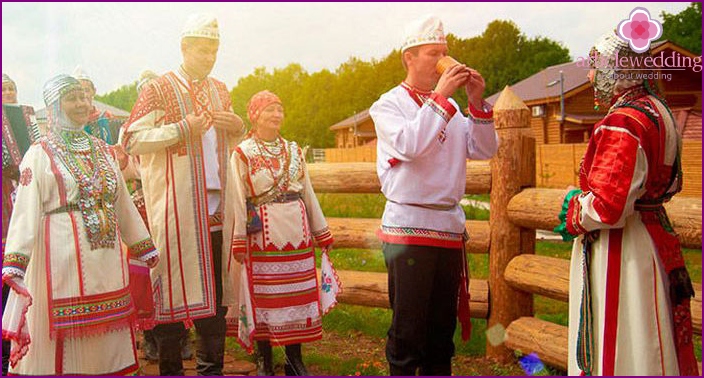
If the matchmakers were able to negotiate with the girl’s parents, a few days later the bride’s parents came to the bride with hotels to meet and final agreement on the dowry and dowry. Relatives of the bride prepared reciprocal refreshments, and the bride, observing the tradition, gave future relatives towels, shirts and other gifts. At this celebration, we agreed on the wedding day - usually three or five (necessarily an odd number) weeks after the matchmaking.
As a dowry for the wedding, they gave household utensils, clothes, livestock and poultry. The kalym that the groom was supposed to pay included money, animal skins, and products for the wedding feast. This Chuvash tradition has survived to this day, but only money is given as kalym, its size may not be agreed in advance (someone pays a large amount, someone symbolic in order to only observe the tradition).
The transfer of money kalym always occurs before the wedding in the newlywed's house. Her relatives put bread and salt on the table, and the father of the groom, according to tradition, should put a wallet with kalym on a loaf. The girl’s father or, if there is no father, relatives of seniority, picking up a kalym, return the wallet with the coin put in it, so that the money from the future relatives is not transferred.
Wedding preparations
The Chuvash wedding ceremony included many rituals and traditions that varied depending on the geographical residence of the Chuvash. Of great importance for the performance of rituals was how the bride was betrayed - with abduction (when the girl was forcibly taken away to the groom's house) or by consent. The Chuvash wedding traditionally begins at the same time in the houses of the couple, then the groom goes to the house of the bridegroom, picks it up, carries it to itself, where the holiday ends.
2-3 days before the wedding, young people (each in his village), along with friends and relatives, went around all relatives. Traditionally, beer for a wedding was also brewed in advance. The Chuvash wedding began with cleaning and a bath for the young and their relatives. After the usual bath for cleanliness, the newlywed was laid yet another - for the rite of purification from evil spirits. Then the young people dressed in new clothes, asked the old people to bless the wedding, after which all the ceremonies and ceremonies began.
Chuvash folk lament song
In some ethnic groups of the Chuvash (grassroots, middle-middle), the ceremony of lamentation of the bride was necessarily performed at the wedding. This tradition has been preserved in some places to this day. On the wedding day, before finally leaving the parental shelter in order to go to the bridegroom, the Chuvash girl had to sing a sad crying song with lamentations about how she did not want to leave her home in a stranger, break away from her relatives.
According to tradition, the married sister (or relative) began to lament at first, showing the young how to. Then the bride and groom picked up and tearfully loudly loudly, recalling parents, brothers, sisters, childhood, native places. Each Chuvash bride composed the song in her own way. Continuing inconsolably howl, the girl hugged alternately all relatives, friends and villagers, as if saying goodbye.
During the crying, the bride and groom gave the approaching ladle of beer where he was supposed to put coins. This money was called according to the Chuvash tradition «tribute to crying» (or «money out»), later the young laid them in the bosom. The rite of crying lasted several hours, until the girl was taken away to the narrowed. It is noteworthy that during the cry of the newlyweds, those gathered in the hut should have been dancing and clapping, trying to amuse the young.
Wedding at the bride's house
While the guests gathered in the house, prayed for the well-being of the young, prepared refreshments and waited for the groom's train, the young and her friends dressed up in a separate room. It was not customary to let the groom’s entire procession go straight to the bride’s house. According to the Chuvash tradition, at first the friends had to pay a symbolic fee to the newlywed father (not a kalym). After that, the guests were allowed inside, the young one was given beer and seated in a special place where the girl’s parents invested money, and the guy took it to himself.
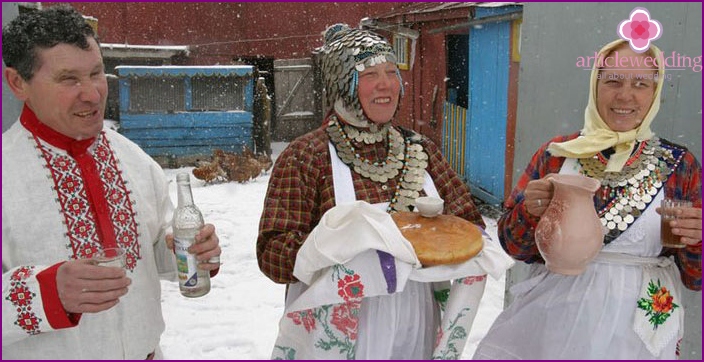
The feast began, the guests had fun, danced, then they led the bride out, covered with a wedding coverlet. The girl began to sing the traditional Chuvash song-lament with lamentations, after which she was taken to the house of the narrowed. When leaving the outskirts, the groom performed a ceremony of expelling evil spirits - he struck the narrowed three times with a whip. The wedding train was returning with songs and music.
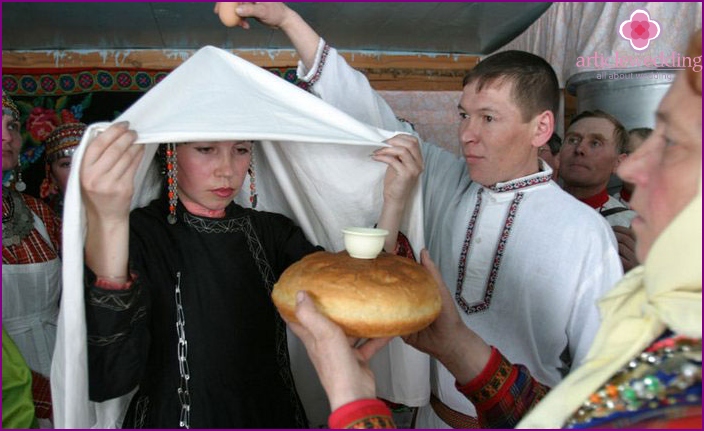
Wedding at the groom's house
While the guests were gathering (relatives, friends, fellow villagers), close relatives dressed the future husband in a Chuvash wedding suit. Then the bride and groom went out into the courtyard with guests, where the first dances with songs began (a friend and bachelor boys were dancing). After dancing, everyone went into the house, treated themselves to a drink. The friend of the groom and the bachelors danced again, everyone had fun, then went to the house of the future wife. Such a train, led by the groom, was traditionally accompanied all the way by music and songs.
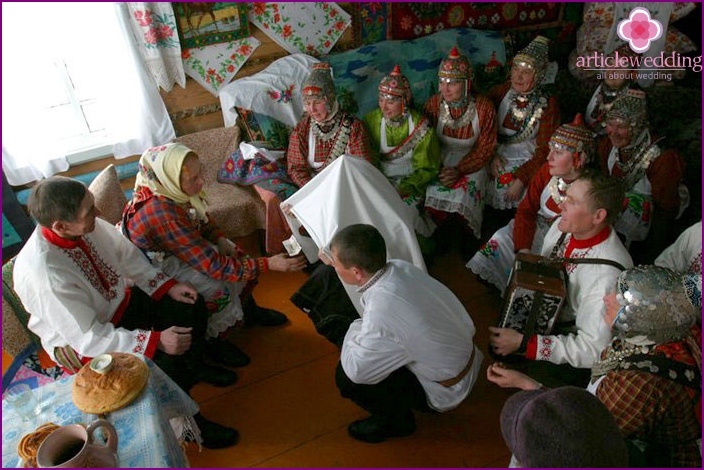
They returned from the bride's house, usually in the evening. Observing the Chuvash rite, the young one was sent to sleep with relatives of the groom, all the participants in the ceremony and relatives of the newlywed remained in his house for the night. The next morning there was a wedding ceremony in the church. After the wedding, everyone returned to the house, they removed the wedding cover from the young, then, according to tradition, they dressed in the clothes of a married woman, and the wedding continued.
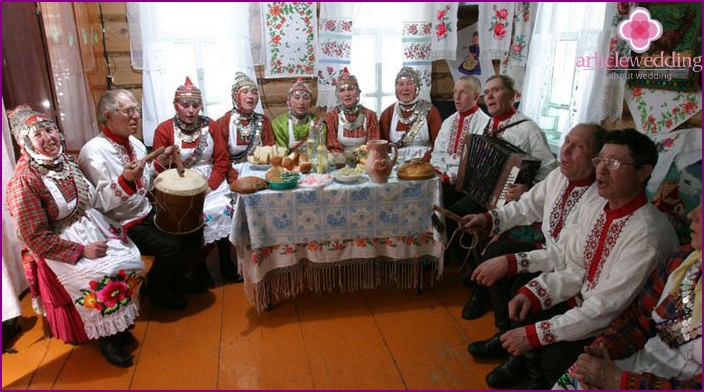
After the wedding, many different Chuvash ceremonies were performed. So, at the gate of the father-in-law near the young they broke a raw egg. In the husband’s house, the couple was necessarily fed with liquid scrambled eggs in milk - this tradition at the wedding symbolized a happy family life. All significant rituals ended with the newlyweds being escorted to the marriage bed: the couple was simply locked for an hour or two in the room, then their daughter-in-law (or matchmaker) lifted them.
After the young people visit the marriage bed, the newly-made wife was traditionally sent for water. The young one was to collect a bucket of water from any source and bring it to the house. At the same time, the sister-in-law kicked the full bucket three times with the foot, and the young one had to pick it up again, only for the fourth time she was allowed to carry water. After all the ceremonies, the guests feasted for another day - at this the Chuvash wedding ended.
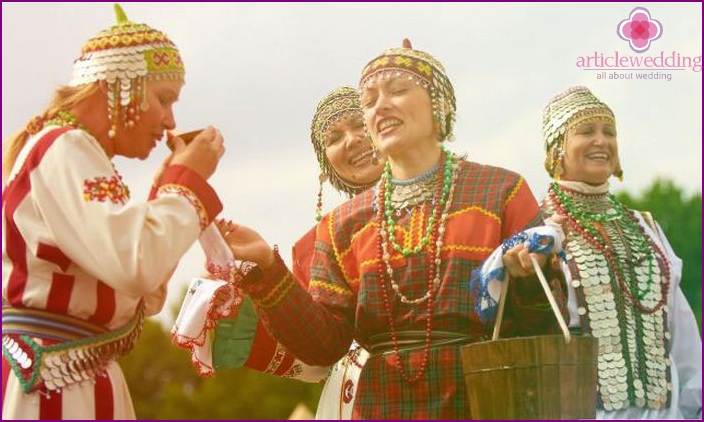
After wedding customs
The first three days after the wedding, the newly-made wife cannot be cleaned. Close relatives do this, and the young one gives them small gifts for this. After the wedding, the bride and groom should give her mother-in-law seven times. In the first year after the wedding day, according to the Chuvash tradition, twin families go to visit each other. So family ties are strengthened.
A week after the wedding, the young parents had to visit the father-in-law. Three weeks later they again went to the father-in-law, but with their parents and one of the relatives. Six months later, 12 people (with the parents of the newly-made husband and relatives) went to the father-in-law’s house, this visit lasted three days, and the young family received the rest of the dowry (livestock).
Another Chuvash tradition forbids newlyweds to sing and dance at a wedding ceremony. It was believed that if the groom would sing songs or dance at his wedding, it would be difficult for a young wife to live in marriage. Young people could have fun for the first time only on their first visit after a wedding day visiting their father-in-law. But modern Chuvash newlyweds often break this tradition by performing their first wedding dance immediately after the ceremony.
National Chuvash wedding clothes
According to the Chuvash custom, the groom put on an embroidered shirt and caftan for the wedding, girdled with a blue or green sash. Mandatory attributes were boots, gloves, a fur hat with a coin near his forehead, a neck ornament with coins and beads. The guy presented the embroidered shawl, presented by the bride during the matchmaking, hung on the belt from the back, and had to hold a whip in his hands. By tradition, the groom could not remove all of the above during the wedding, even in hot weather.
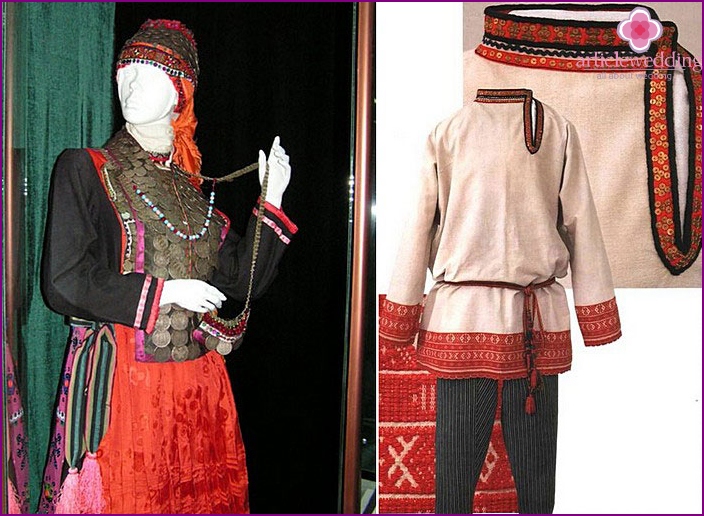
The full wedding attire of the Chuvash bride, along with jewelry, weighed more than 15 kg, of which 2-3 kg were accounted for by silver coins, which abundantly embroidered a headdress and a special ribbon-cape over his shoulder. The shirt, apron and outerwear (bathrobe or caftan) were also traditionally decorated with embroidery. Numerous jewelry were obligatory attributes of the Chuvash women's wedding attire: rings, bracelets, neck, chest and waist pendants, a purse and a mirror, suspended on a belt.
According to tradition, wedding clothes, especially the newlywed hat, were completely embroidered with bead patterns, shells and coins. The drawings on the Chuvash costume were usually geometric and had a secret ritual meaning, and the coins were sewn in such a way that they could make a melodious ringing when moving, so the Chuvash never had silence at the wedding. The bride’s bedspread must be white with embroidery on the edges..
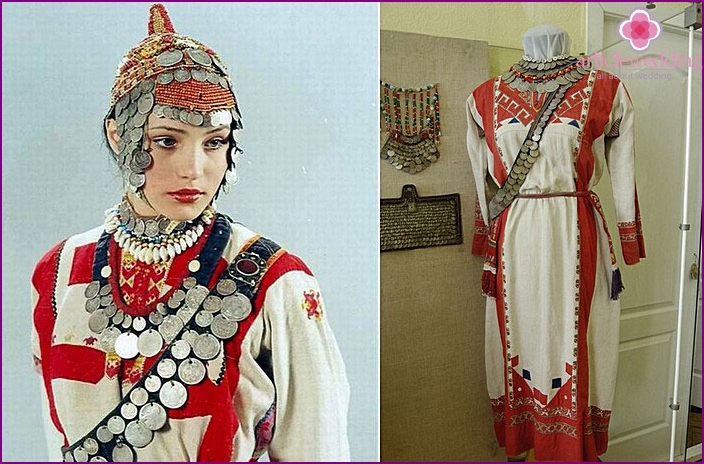
Video: Chuvash wedding ritual before the wedding
Chuvash wedding is a noisy process filled with numerous rituals. The fun lasts several days, the whole village participates in it. Modern Chuvash people rarely observe wedding traditions completely, but some customs are still popular. The newlyweds' outfits and rituals at the Chuvash wedding are a spectacular sight to be seen even from afar. You can watch the amazing rites of the Chuvash people by watching the video below.
